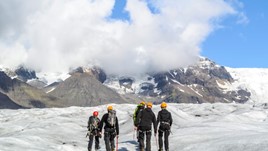
By James Taylor
Travel Writer16 Feb 2018 - 6 Minute Read
“I’ve heard conditions are good, but we’ll find out when we get there,” says Ingvar, green eyes glowing above a beard flecked with snow. “Hopefully the weather holds, and we won’t have to turn back.” As he speaks, I can spy a swirling mass of grey clouds further to the west, threatening snow.
The wind is starting to pull at my jacket, threading its way inside. I clench it tighter around me and turn my attention towards the towering edge of the glacier, where its jagged blue teeth emerge from a bank of clouds only to vanish again moments later.
It’s just after 10am on a bleak winter’s morning in Vatnajökull National Park, south-east Iceland. The largest glacier in Europe, Vatnajökull, lies just ahead of us; the behemoth ice cap covers around eight percent of Iceland, hiding away three different volcanoes, glacial lakes and rivers, and even Iceland’s tallest mountain. Today we’re hiking across it towards a pair of ice caves simply called “Treasure Island.”
“It’ll take roughly an hour and a half to get to the caves. The glacier always makes it a challenge,” says Ingvar.
It’s a surreal world, one in which humans don’t really belong.
We’re gearing up for our hike across the ice. He hands me a helmet, harness, and crampons. My favourite comes last – an ice pick, which I hope I’ll have to slam into the glacier to stop me from careening into a bottomless chasm. We take off in single file into the glacial realm.
It’s a surreal world, one in which humans don’t really belong.
A booming crack thunders across from over the next rise – the glacier is breaking apart and crashing into the lagoon. Spirals of air are trapped below us in the ice, straining to reach the surface. A howling wind blows down from above us where the glacier disappears into a shroud of mist, rustling up sharp shards of ice and snow that pepper us as we walk. The icy tundra is alive, and brimming with power.
“At one point, the glacier covered all Jökulsárlón,” says Ingvar, gesturing at the lagoon below us. “Now, it’s beating a hasty retreat – in 120 years, it has retreated a total of 500 years’ worth of growth.”
While we walk, Ingvar also talks about the weight of tourism on Iceland, the need to further spread tourists out to lesser-known locations. “There are 27 separate groups touring the more accessible cave right now,” he says. I’m glad for our isolation on the glacier, and appreciate for the first time that spreading tourism around doesn’t just benefit Iceland’s environment – the tourists benefit from it, too.
After an hour of hard hiking across the ice, we descend toward the shore line and caves. All is silent but for the dripping of water across the entrance – a gaping black hole burrowing under the ice shelf. Ours is the only group here.

We enter the frozen world of crystal blue, light glinting off the ice in rays of sapphire and cobalt. Streaks of black ash hide deep within, swallowing the light from our torches – the glacier’s memories from ancient eruptions, permanently encased inside.
“The glacier is constantly shifting, moving. Old caves change, and new ones form each year. This won’t be here next winter,” Ingvar says, a bit sadly. His concern about the glacier’s retreat is obvious. We walk in silence towards the end of the cave, the walls softly illuminated through holes in the roof. It’s a venerable cathedral of light and ice.
How many caves like this lie undiscovered across the icy tundra above us? And how much are humans contributing to their demise? The howl of the wind suddenly sounds to me like the time-worn scream of an ancient, living entity, chasing us away from its hidden treasures.
It strikes me how vulnerable the glacier is, despite its size. I begin to feel Ingvar’s connection with this vast being, and resolve to always be protective of Iceland’s fragile landscapes.
Back outside the caves, I ask Ingvar whether the glacier will advance again. “It will always retreat and advance, that’s the one thing we know.” His gaze drifts towards the distant mountains, a spine of peaks which once stood above the spilling glacier. “Look over there. You can see it left something behind,” he says.
Sure enough, glinting in the weak sunlight is the tell-tale blue glow of some glacial ice, cut off from the main body and partly concealed by a cascade of rocks. The glacier has been wily enough to leave some hidden reserves behind in its retreat, waiting for the advance to come again.
Discover similar stories in
connection
Travel Writer
James is an Australian freelance writer who frequently finds himself wandering off into the unknown. He currently lives on the frozen rock that is Iceland.




No Comments